Alexander H. Liu
Voxtral
Jul 17, 2025Abstract:We present Voxtral Mini and Voxtral Small, two multimodal audio chat models. Voxtral is trained to comprehend both spoken audio and text documents, achieving state-of-the-art performance across a diverse range of audio benchmarks, while preserving strong text capabilities. Voxtral Small outperforms a number of closed-source models, while being small enough to run locally. A 32K context window enables the model to handle audio files up to 40 minutes in duration and long multi-turn conversations. We also contribute three benchmarks for evaluating speech understanding models on knowledge and trivia. Both Voxtral models are released under Apache 2.0 license.
USAD: Universal Speech and Audio Representation via Distillation
Jun 23, 2025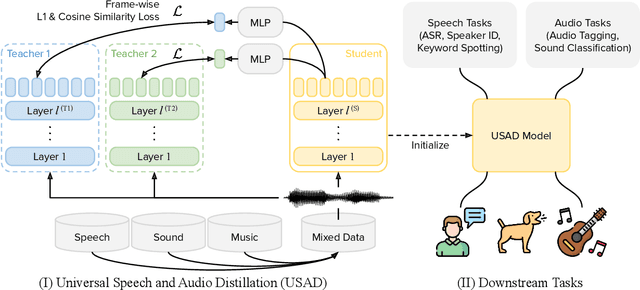
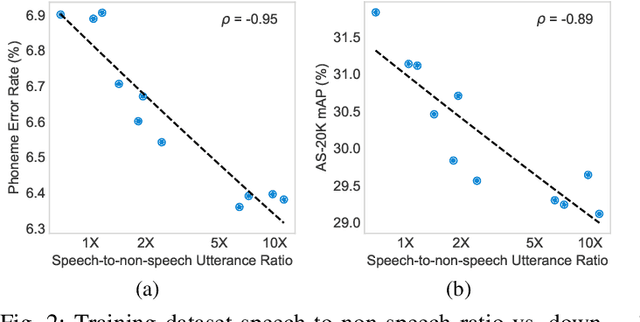
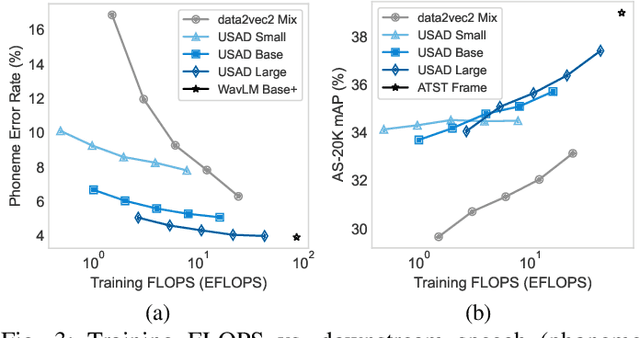
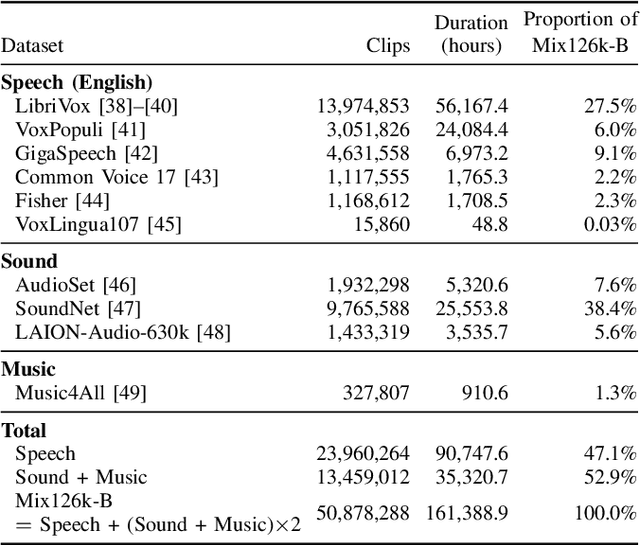
Abstract:Self-supervised learning (SSL) has revolutionized audio representations, yet models often remain domain-specific, focusing on either speech or non-speech tasks. In this work, we present Universal Speech and Audio Distillation (USAD), a unified approach to audio representation learning that integrates diverse audio types - speech, sound, and music - into a single model. USAD employs efficient layer-to-layer distillation from domain-specific SSL models to train a student on a comprehensive audio dataset. USAD offers competitive performance across various benchmarks and datasets, including frame and instance-level speech processing tasks, audio tagging, and sound classification, achieving near state-of-the-art results with a single encoder on SUPERB and HEAR benchmarks.
Magistral
Jun 12, 2025Abstract:We introduce Magistral, Mistral's first reasoning model and our own scalable reinforcement learning (RL) pipeline. Instead of relying on existing implementations and RL traces distilled from prior models, we follow a ground up approach, relying solely on our own models and infrastructure. Notably, we demonstrate a stack that enabled us to explore the limits of pure RL training of LLMs, present a simple method to force the reasoning language of the model, and show that RL on text data alone maintains most of the initial checkpoint's capabilities. We find that RL on text maintains or improves multimodal understanding, instruction following and function calling. We present Magistral Medium, trained for reasoning on top of Mistral Medium 3 with RL alone, and we open-source Magistral Small (Apache 2.0) which further includes cold-start data from Magistral Medium.
Full-Duplex-Bench: A Benchmark to Evaluate Full-duplex Spoken Dialogue Models on Turn-taking Capabilities
Mar 06, 2025Abstract:Spoken dialogue modeling introduces unique challenges beyond text-based language modeling, demanding robust turn-taking, backchanneling, and real-time interaction. Although most Spoken Dialogue Models (SDMs) rely on half-duplex processing (handling speech one turn at a time), emerging full-duplex SDMs can listen and speak simultaneously, enabling more natural and engaging conversations. However, current evaluations of such models remain limited, often focusing on turn-based metrics or high-level corpus analyses (e.g., turn gaps, pauses). To address this gap, we present Full-Duplex-Bench, a new benchmark that systematically evaluates key conversational behaviors: pause handling, backchanneling, turn-taking, and interruption management. Our framework uses automatic metrics for consistent and reproducible assessments of SDMs' interactive performance. By offering an open and standardized evaluation benchmark, we aim to advance spoken dialogue modeling and encourage the development of more interactive and natural dialogue systems.
SHuBERT: Self-Supervised Sign Language Representation Learning via Multi-Stream Cluster Prediction
Nov 25, 2024
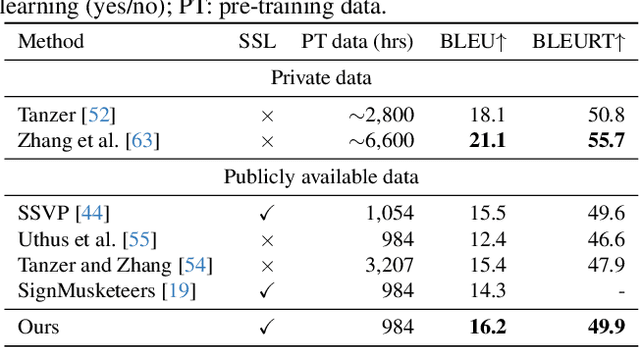

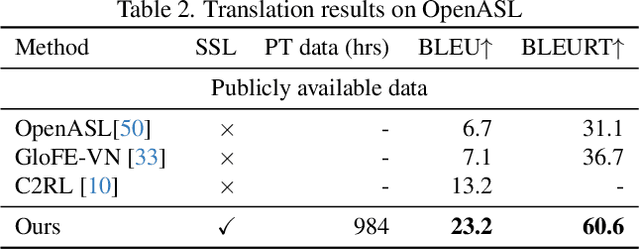
Abstract:Sign language processing has traditionally relied on task-specific models,limiting the potential for transfer learning across tasks. We introduce SHuBERT (Sign Hidden-Unit BERT), a self-supervised transformer encoder that learns strong representations from approximately 1,000 hours of American Sign Language (ASL) video content. Inspired by the success of the HuBERT speech representation model, SHuBERT adapts masked prediction for multi-stream visual sign language input, learning to predict multiple targets for corresponding to clustered hand, face, and body pose streams. SHuBERT achieves state-of-the-art performance across multiple benchmarks. On sign language translation, it outperforms prior methods trained on publicly available data on the How2Sign (+0.7 BLEU), OpenASL (+10.0 BLEU), and FLEURS-ASL (+0.3 BLEU) benchmarks. Similarly for isolated sign language recognition, SHuBERT's accuracy surpasses that of specialized models on ASL-Citizen (+5\%) and SEM-LEX (+20.6\%), while coming close to them on WLASL2000 (-3\%). Ablation studies confirm the contribution of each component of the approach.
A Closer Look at Neural Codec Resynthesis: Bridging the Gap between Codec and Waveform Generation
Oct 29, 2024


Abstract:Neural Audio Codecs, initially designed as a compression technique, have gained more attention recently for speech generation. Codec models represent each audio frame as a sequence of tokens, i.e., discrete embeddings. The discrete and low-frequency nature of neural codecs introduced a new way to generate speech with token-based models. As these tokens encode information at various levels of granularity, from coarse to fine, most existing works focus on how to better generate the coarse tokens. In this paper, we focus on an equally important but often overlooked question: How can we better resynthesize the waveform from coarse tokens? We point out that both the choice of learning target and resynthesis approach have a dramatic impact on the generated audio quality. Specifically, we study two different strategies based on token prediction and regression, and introduce a new method based on Schr\"odinger Bridge. We examine how different design choices affect machine and human perception.
Generative Speech Foundation Model Pretraining for High-Quality Speech Extraction and Restoration
Sep 25, 2024Abstract:This paper proposes a generative pretraining foundation model for high-quality speech restoration tasks. By directly operating on complex-valued short-time Fourier transform coefficients, our model does not rely on any vocoders for time-domain signal reconstruction. As a result, our model simplifies the synthesis process and removes the quality upper-bound introduced by any mel-spectrogram vocoder compared to prior work SpeechFlow. The proposed method is evaluated on multiple speech restoration tasks, including speech denoising, bandwidth extension, codec artifact removal, and target speaker extraction. In all scenarios, finetuning our pretrained model results in superior performance over strong baselines. Notably, in the target speaker extraction task, our model outperforms existing systems, including those leveraging SSL-pretrained encoders like WavLM. The code and the pretrained checkpoints are publicly available in the NVIDIA NeMo framework.
ESPnet-Codec: Comprehensive Training and Evaluation of Neural Codecs for Audio, Music, and Speech
Sep 24, 2024Abstract:Neural codecs have become crucial to recent speech and audio generation research. In addition to signal compression capabilities, discrete codecs have also been found to enhance downstream training efficiency and compatibility with autoregressive language models. However, as extensive downstream applications are investigated, challenges have arisen in ensuring fair comparisons across diverse applications. To address these issues, we present a new open-source platform ESPnet-Codec, which is built on ESPnet and focuses on neural codec training and evaluation. ESPnet-Codec offers various recipes in audio, music, and speech for training and evaluation using several widely adopted codec models. Together with ESPnet-Codec, we present VERSA, a standalone evaluation toolkit, which provides a comprehensive evaluation of codec performance over 20 audio evaluation metrics. Notably, we demonstrate that ESPnet-Codec can be integrated into six ESPnet tasks, supporting diverse applications.
Codec-SUPERB @ SLT 2024: A lightweight benchmark for neural audio codec models
Sep 21, 2024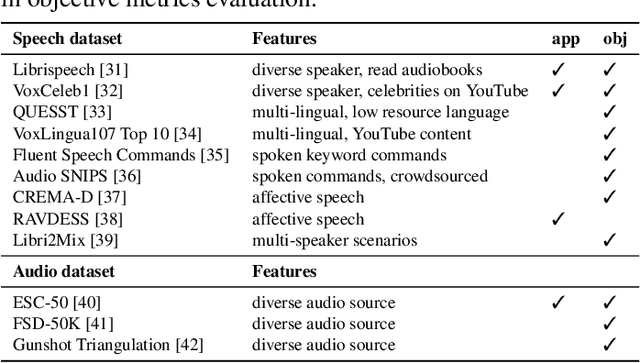
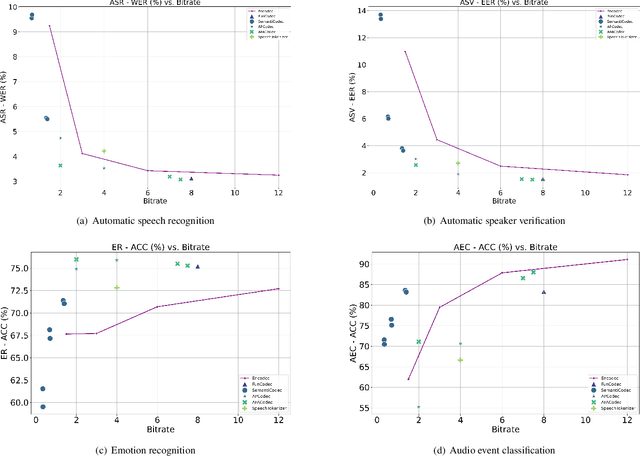
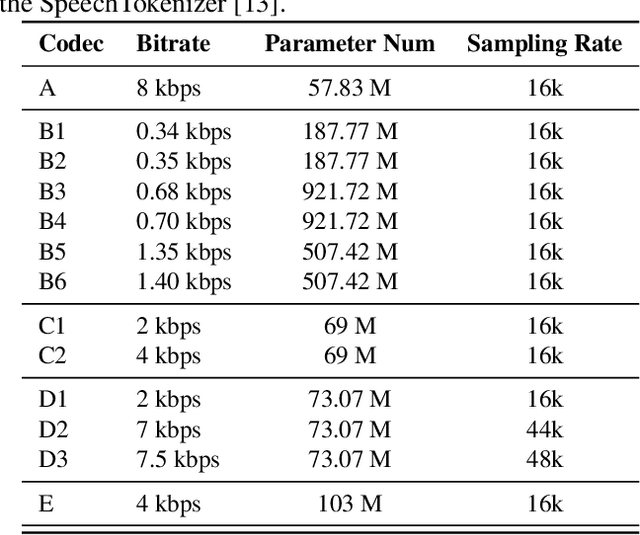
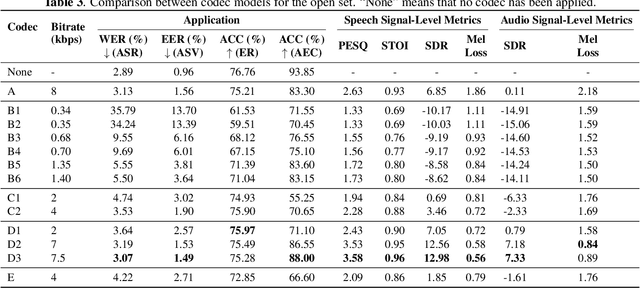
Abstract:Neural audio codec models are becoming increasingly important as they serve as tokenizers for audio, enabling efficient transmission or facilitating speech language modeling. The ideal neural audio codec should maintain content, paralinguistics, speaker characteristics, and audio information even at low bitrates. Recently, numerous advanced neural codec models have been proposed. However, codec models are often tested under varying experimental conditions. As a result, we introduce the Codec-SUPERB challenge at SLT 2024, designed to facilitate fair and lightweight comparisons among existing codec models and inspire advancements in the field. This challenge brings together representative speech applications and objective metrics, and carefully selects license-free datasets, sampling them into small sets to reduce evaluation computation costs. This paper presents the challenge's rules, datasets, five participant systems, results, and findings.
Codec-SUPERB: An In-Depth Analysis of Sound Codec Models
Feb 20, 2024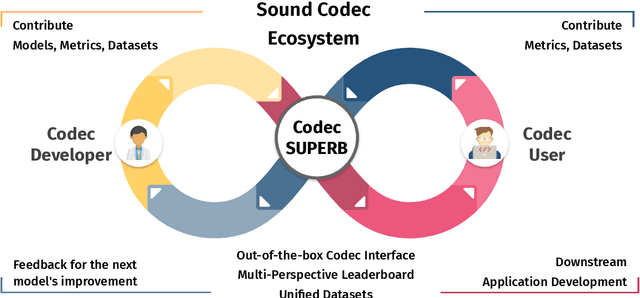
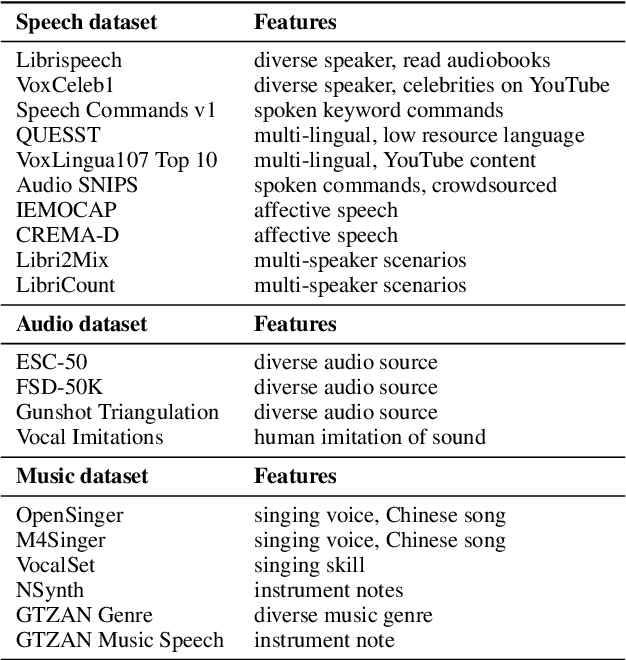
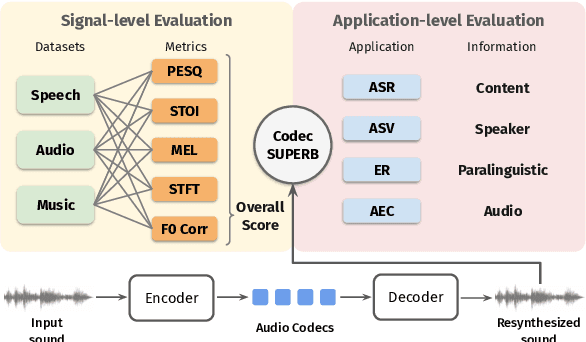
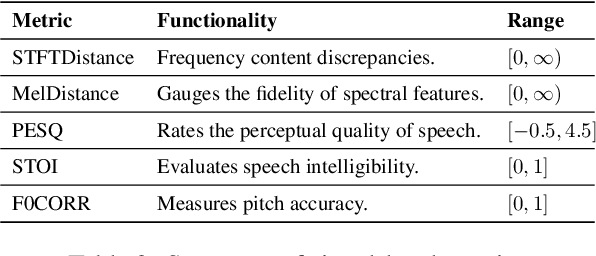
Abstract:The sound codec's dual roles in minimizing data transmission latency and serving as tokenizers underscore its critical importance. Recent years have witnessed significant developments in codec models. The ideal sound codec should preserve content, paralinguistics, speakers, and audio information. However, the question of which codec achieves optimal sound information preservation remains unanswered, as in different papers, models are evaluated on their selected experimental settings. This study introduces Codec-SUPERB, an acronym for Codec sound processing Universal PERformance Benchmark. It is an ecosystem designed to assess codec models across representative sound applications and signal-level metrics rooted in sound domain knowledge.Codec-SUPERB simplifies result sharing through an online leaderboard, promoting collaboration within a community-driven benchmark database, thereby stimulating new development cycles for codecs. Furthermore, we undertake an in-depth analysis to offer insights into codec models from both application and signal perspectives, diverging from previous codec papers mainly concentrating on signal-level comparisons. Finally, we will release codes, the leaderboard, and data to accelerate progress within the community.
 Add to Chrome
Add to Chrome Add to Firefox
Add to Firefox Add to Edge
Add to Edge